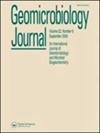温度和微生物对煤矿水化学特性的相互影响
IF 2.2
4区 环境科学与生态学
Q3 ENVIRONMENTAL SCIENCES
引用次数: 0
摘要
摘要煤矿开采活动产生的矿井排水成为区域地下水的潜在污染物。含水层和岩层中的温度和微生物群落随着煤矿开采深度的增加而变化。而温度和微生物对矿井水化学特性的影响机制尚不清楚。本研究调查了中国北方一个典型的雷场,并进行了水-岩(煤)孵化实验,探讨了温度和微生物对矿井水化学特性的影响。新聚龙煤矿采空区及主要充水含水层的矿井水化学类型为SO4–Na型。变形菌门和厚壁菌门是煤矿水中主要的细菌门。随着采空区封闭时间的延长,矿井水中SO4 2−浓度降低,微生物多样性增加。28天的培养实验发现,当温度升高10℃时,Na+和SO4 2−分别略有增加5.13%和6.67%,HCO3−减少14.33% °C。水煤系统细菌群落的Shannon指数增加了6.7%,Hydrogenophaga的相对丰度减少了22.7%,而硫杆菌的相对丰度增加了31.56%。微生物活性分别降低了2.31%和4.95%,但HCO3−增加了7.59%。功能预测表明,微生物发生了硫转化反应,并影响了离子在矿井水中的溶解。这些结果对于理解温度和微生物对煤矿水化学特性的相互影响至关重要。图形摘要本文章由计算机程序翻译,如有差异,请以英文原文为准。
Mutual Effects of Temperature and Microorganisms on the Chemical Characteristics of Coal Mine Drainage
Abstract Coal mining activities produce coal mine drainage which becomes a potential pollutant of regional groundwater. The temperature and microbial community in aquifers and rock formations change with coal mining depth increases. While the influence mechanisms of temperature and microorganisms on the hydrochemical characteristics of mine water are poorly understood. This study investigated a typical minefield in north China and performed the water–rock (coal) incubation experiments to explore the effect of temperature and microorganisms on the chemical characteristics of mine water. Hydrochemistry type of coal mine water in the goafs and main water-filled aquifers of Xinjulong coal mine was the SO4–Na type. Proteobacteria and Firmicutes were the main bacterial phyla in the coal mine water. The increasing closure time of goafs decreased SO4 2− concentration and increased the microbial diversity in mine water. The 28-day incubation experiments found Na+ and SO4 2− slightly increased by 5.13 and 6.67%, respectively, and HCO3 − decreased by 14.33% when the temperature rose by 10 °C. The Shannon index of the bacterial community in water–coal system increased by 6.7% and the relative abundance of Hydrogenophaga decreased by 22.7%, while that of Thiobacillus increased by 31.56%. The microbial activities decreased Na+ and SO4 2− by 2.31 and 4.95%, respectively, but increased HCO3 − by 7.59%. The functional prediction showed the microorganisms undergone sulfur conversion reactions and affected the dissolution of ions in mine water. The results were crucial for understanding the mutual effects of temperature and microorganisms on the hydrochemical characteristics of coal mine water. GRAPHICAL ABSTRACT
求助全文
通过发布文献求助,成功后即可免费获取论文全文。
去求助
来源期刊

Geomicrobiology Journal
环境科学-地球科学综合
CiteScore
4.80
自引率
8.70%
发文量
70
审稿时长
3.3 months
期刊介绍:
Geomicrobiology Journal is a unified vehicle for research and review articles in geomicrobiology and microbial biogeochemistry. One or two special issues devoted to specific geomicrobiological topics are published each year. General articles deal with microbial transformations of geologically important minerals and elements, including those that occur in marine and freshwater environments, soils, mineral deposits and rock formations, and the environmental biogeochemical impact of these transformations. In this context, the functions of Bacteria and Archaea, yeasts, filamentous fungi, micro-algae, protists, and their viruses as geochemical agents are examined.
Articles may stress the nature of specific geologically important microorganisms and their activities, or the environmental and geological consequences of geomicrobiological activity.
The Journal covers an array of topics such as:
microbial weathering;
microbial roles in the formation and degradation of specific minerals;
mineralization of organic matter;
petroleum microbiology;
subsurface microbiology;
biofilm form and function, and other interfacial phenomena of geological importance;
biogeochemical cycling of elements;
isotopic fractionation;
paleomicrobiology.
Applied topics such as bioleaching microbiology, geomicrobiological prospecting, and groundwater pollution microbiology are addressed. New methods and techniques applied in geomicrobiological studies are also considered.
 求助内容:
求助内容: 应助结果提醒方式:
应助结果提醒方式:


